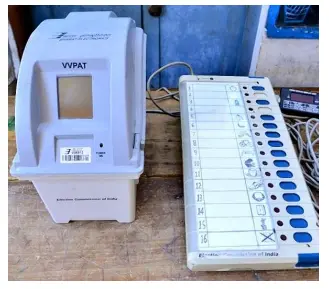Saturday, 13th April 2024
India's Rejection of Chinese Claim Over Arunachal Pradesh
In News: India recently rejected China's attempt to rename some places in Arunachal Pradesh, stating that assigning "invented" names does not change the reality that the state "is, has been, and will always be" an integral part of India.
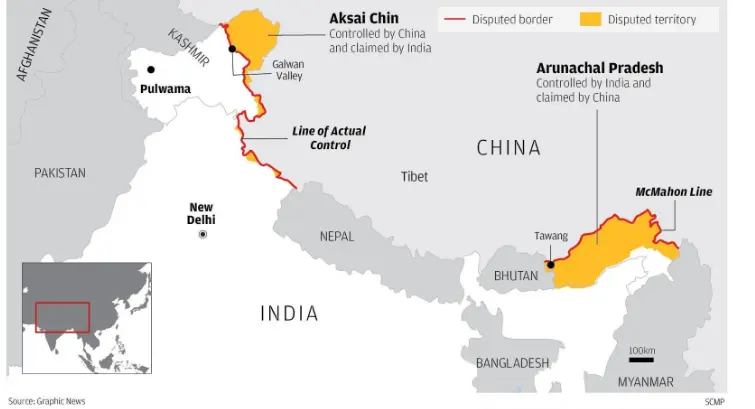
Background of the India-China Border Dispute
The India-China border dispute involves territorial conflicts along their shared border spanning 3,488 kilometers. Key disputed areas include Aksai Chin in the western sector and Arunachal Pradesh in the eastern sector.
- Aksai Chin
- China administers Aksai Chin as part of its Xinjiang region, while India considers it part of its Union Territory of Ladakh. This region holds strategic importance due to its proximity to the China-Pakistan Economic Corridor (CPEC) and its military significance.
- Arunachal Pradesh
- China claims the entire state of Arunachal Pradesh, referring to it as "South Tibet". India administers this region as a northeastern state and considers it integral to its territory.
No Clear Demarcation
The border lacks a mutually agreed Line of Actual Control (LAC) along certain stretches, with the LAC being established post the 1962 Sino-Indian War.
Military Standoffs
Past military confrontations include the 1962 Sino-Indian War, while recent standoffs occurred in Doklam in 2017, Galwan Valley in Ladakh in 2020, and Tawang in Arunachal Pradesh in 2022.
India's Response to Chinese Aggression
- Global Strategic Alliances
- India actively collaborates with like-minded nations to counter China's influence, participating in alliances like the QUAD and I2U2.
- IMEC and INSTC
- Initiatives like the India-Middle East-Europe Economic Corridor (IMEC) and International North-South Transport Corridor (INSTC) offer alternatives to China's Belt and Road Initiative (BRI) and CPEC.
- Necklace of Diamonds Strategy
- India's strategy involves bolstering naval presence, expanding military bases, and strengthening diplomatic ties to counter China's String of Pearls strategy.
- Infrastructure Development
- India is enhancing border infrastructure with projects by the Border Roads Organisation (BRO), focusing on regions like Arunachal Pradesh, Ladakh, and Jammu and Kashmir.
- Cooperation with Neighbors
- Regional partnerships with neighboring countries, such as supporting Bhutan's Gelephu mindfulness city and signing power pacts with Nepal, aim to reduce Chinese influence and enhance regional stability.
Way Forward
- Invest in Border Infrastructure
- Upgrading roads, bridges, airstrips, and communication networks is essential for improving mobility and response capabilities.
- Modernize Armed Forces
- Investment in advanced equipment, technology, and surveillance capabilities is crucial for effective monitoring and response to border incidents.
- Fortify Alliances
- Strengthening alliances with like-minded nations and regional organizations is necessary to address concerns regarding Chinese assertiveness.
- Diversify Economic Ties
- Efforts to reduce reliance on China and bolster economic resilience involve exploring trade agreements and partnerships with alternative markets and investment opportunities.
|
UPSC Previous Year Questions Prelims (2020) Q. Siachen Glacier is situated to the (a) East of Aksai Chin Ans (d) Mains (2016) Q. Border management is a complex task due to difficult terrain and hostile relations with some countries. Elucidate the challenges and strategies for effective border management. |
Source: IE
Apple Alerts iPhone Users About Mercenary Spyware Threat
In News: Recently, Apple sent out warnings to iPhone users in India and 91 other countries, informing them that their devices might be under attack by a type of spyware known as mercenary spyware, including one called Pegasus.
Spyware and Malware
Spyware and malware are types of harmful software designed to infiltrate and damage computers or devices. They operate with distinct purposes:
- Spyware
- Spyware focuses on spying on a user's activities, such as browsing habits, keystrokes, or personal information, without their consent. Key points include:
- It gathers data for advertising purposes or identity theft.
- Spyware aims to monitor users' movements and communications without their knowledge.
- Malware
- Malware, short for malicious software, encompasses a broader range of harmful programs, including viruses, worms, and ransomware. Key points include:
- Malware aims to disrupt, damage, or gain unauthorized access to computer systems or networks.
- It includes various types like viruses, worms, and ransomware.
Mercenary Spyware Attacks
Mercenary spyware attacks are highly complex and target specific individuals with exceptional resources. Key points include:
- These attacks are difficult to detect and prevent due to substantial investment and short lifespan.
- They are among the most sophisticated digital threats globally.
- Governments, intelligence agencies, and law enforcement bodies reportedly utilize mercenary spyware to target political opponents and activists.
Examples of Mercenary Spyware
Companies producing mercenary spyware include the NSO Group, FinFisher, and Hacking Team. Key points include:
- NSO Group's Pegasus spyware remotely infiltrates devices and accesses calls, emails, and messages.
- Finfisher's FinSpy captures keystrokes and activates microphones and cameras without permission.
- Hacking Team's Galileo (RCS) captures keystrokes, records video calls, and accesses cameras and microphones.
Pegasus Spyware
Pegasus, developed by Israel’s NSO Group, is a malware/spyware suite designed to access any smartphone through zero-click vulnerabilities. Key points include:
- It can access entire data on infiltrated smartphones, including emails, texts, and calls.
- Pegasus has real-time access to the smartphone's camera and sound recording capabilities.
Zero-click Exploit
A zero-click exploit installs malicious software on a device without the owner’s consent or any actions from the owner. Key points include:
- The exploit used in the present case involving Indian journalists is called BLASTPAST.
- It operates in two phases, attempting to establish a link with Apple HomeKit and delivering the full spyware payload via iMessage.
Source: IT
ISRO Achieves Zero Orbital Debris Milestone
In News: ISRO launched a mission named PSLV-C58/XPoSat and ensured it left no debris in space.
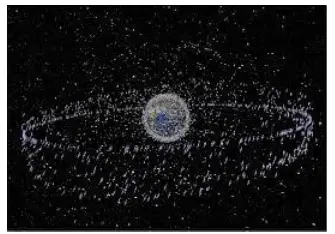
About POEM
- The Vikram Sarabhai Space Centre (VSSC) developed POEM as an inexpensive space platform using the spent fourth stage of a PSLV rocket.
- It debuted in the PSLV-C53 mission in June 2022, orbiting the earth to conduct in-orbit scientific experiments with various payloads.
Features of POEM
- POEM is powered by solar panels mounted on the rocket’s fourth stage fuel tank and a lithium-ion (Li-ion) battery.
- It features a dedicated navigation, guidance, and control (NGC) system, along with helium control thrusters for altitude stabilization.
- POEM communicates with ISRO’s NavIC satellite constellation for navigation and employs a telecommand system for ground station communication.
Achievement of POEM-3
- POEM-3 carried nine payloads and completed 400 orbits around the earth within 25 days, facilitating operational experiments.
Space Debris: A Challenge
- Space debris, composed of spacecraft fragments and defunct satellites, poses a significant threat due to its increasing volume.
- The low earth orbit (LEO), spanning from 100 km to 2000 km above the earth, harbors a growing number of satellites, raising concerns.
- ISRO's Space Situational Assessment report 2022 noted 2,533 objects placed in space via 179 launches in 2022, contributing to debris accumulation.
Threats and Risks
- Space debris, traveling at high speeds, endangers space assets and poses risks on the ground, as evidenced by recent incidents.
- The accumulation of debris can lead to the Kessler syndrome, causing cascading collisions and further debris creation.
Dealing with Space Debris
- International efforts, guided by the Space Debris Mitigation Guidelines 2002, aim to limit collisions and debris proliferation.
- NASA, ESA, China, Japan, and India have undertaken initiatives ranging from tracking and removal technologies to in-space refueling and de-orbiting strategies.
- ISRO's POEM missions and the establishment of a Space Situational Awareness Control Centre reflect India's commitment to mitigating space debris and protecting high-value assets. Additionally, initiatives by Indian startups like Manastu Space contribute to advancing space debris management technologies.
Source: TH
DGCA’s Flight Duty Time Limitation Rules
In News: The Directorate General of Civil Aviation has communicated with Indian airlines, requesting them to specify their readiness to implement the new Flight Duty Time Limitation (FDTL) rules.
About Directorate General of Civil Aviation (DGCA)
DGCA serves as the regulatory body for Civil Aviation, primarily focusing on safety issues. Key points about DGCA include:
- It obtained statutory status under the Aircraft (Amendment) Bill, 2020.
- Responsibilities encompass regulating air transport services to/from/within India, enforcing civil air regulations, and ensuring air safety and airworthiness standards.
- It coordinates regulatory functions with the International Civil Aviation Organisation (ICAO) and is headquartered in New Delhi.
Functions of DGCA
- Registration of civil aircraft.
- Certification of airports.
- Licensing of pilots, aircraft maintenance engineers, air traffic controllers, and flight engineers.
- Formulation and implementation of airworthiness standards for civil aircraft.
- Investigation of incidents involving aircraft weighing up to 2250 kg AUW.
- Accident prevention measures, including Safety Aviation Management Programmes.
- Proficiency checks for flight crew and operational personnel.
- Granting Air Operator's Certificates to Indian carriers and regulating air transport services.
- Approval of institutes engaged in flying training.
- Safety oversight of entities certified under the Aircraft Rules 1937.
About Flight Duty Time Limitation Rules
Flight crew fatigue is a concern in aviation, leading to human errors and health risks. Key points about the Flight Duty Time Limitation (FDTL) Rules include:
- The International Civil Aviation Organization (ICAO) mandates countries to establish regulations for managing fatigue.
- DGCA issued FDTL Rules in 2019, setting limits on flight duty periods, rest periods, and cumulative flight time.
- The rules aim to prevent airlines from exceeding prescribed time limitations and mandate them to establish their own fatigue management limitations within DGCA's framework.
Source: IE
"Mother of Dragons"
In News: The celestial phenomenon, commonly referred to as the "Mother of Dragons" comet and formally designated as Comet 12P/Pons-Brooks, is presently experiencing a rare appearance in the skies of the Northern Hemisphere.

Unique Characteristics of Comet "Mother of Dragons"
- Discovered in the early 19th century, this comet is renowned for its distinctive green glow, which is attributed to the presence of diatomic carbon molecules within it.
- Notably, it exhibits volcanic activity, a rare trait among comets. These eruptions expel ice and dust from its core, enhancing its brightness and visibility from Earth, leading to its nickname "Mother of Dragons."
- Classified as a Halley-type comet, it boasts a relatively short orbital period compared to others, completing a single orbit around the sun in just over seven decades. Its last appearance near Earth was in 1954, with the next anticipated encounter projected for the mid-2090s.
- Belonging to the category of Jupiter-family comets, its trajectory is influenced by the gravitational pull of Jupiter.
- The periodic nature of this comet offers valuable insights into comet dynamics and the evolution of our solar system.
Source: TOI
World Homoeopathy Day 2024
In News: Recently, the President of India inaugurated a two-day Homoeopathy Symposium organized by the Central Council for Research in Homoeopathy to commemorate World Homoeopathy Day.
World Homoeopathy Day 2024: Uniting for One Health, One Family
- The theme of the symposium, "Empowering Research, Enhancing Proficiency," holds significant relevance in the field of homoeopathy.
- Homoeopathy is a medical system centered on the belief that the body possesses an inherent ability to heal itself.
- Practitioners of homoeopathy advocate for the use of highly diluted substances to stimulate the body's self-healing mechanisms while minimizing potential side effects.
- World Homoeopathy Day is celebrated annually on April 10th to honor the birth anniversary of Dr. Hahnemann, the Founder of Homoeopathy.
- The theme for the year 2024 is "Homeoparivar: One Health, One Family," emphasizing unity and holistic health within the homoeopathic community.
Source: PIB
Wayanad Wildlife Sanctuary
In News: Recently, a fire ravaged close to 100 hectares of forest in the Sulthan Bathery forest range within the Wayanad Wildlife Sanctuary (WWS).
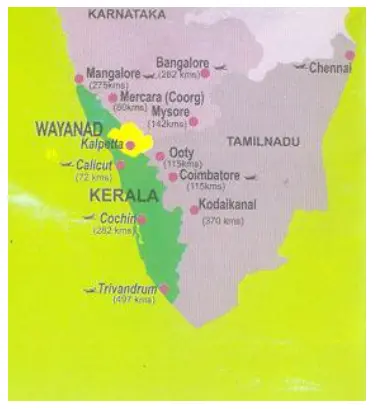
Overview of Wayanad Wildlife Sanctuary (WWS)
- Wayanad Wildlife Sanctuary (WWS) is situated in Wayanad, Kerala, within the southern stretches of the Western Ghats.
- The sanctuary forms an integral part of the Nilgiri Biosphere Reserve, a UNESCO World Heritage Site.
- Established in 1973, it spans an area of approximately 344.44 square kilometers.
- The sanctuary shares borders with the protected areas of Nagarhole and Bandipur in Karnataka to the northeastern side, and Mudumalai in Tamil Nadu to the southeastern side.
- Several tribes inhabit these forests, including scheduled adivasis such as Paniyas, Kattunaikkans, Kurumas, Ooralis, Adiyans, and Kurichiyas.
- Flora of Wayanad Wildlife Sanctuary (WWS)
- The sanctuary features a diverse range of vegetation typical of the Western Ghats, including moist deciduous, dry deciduous, and semi-evergreen patches.
- About one-third of the sanctuary is covered by plantations of teak, rosewood, eucalyptus, and silver oak.
- Marshy lands also contribute to the sanctuary's ecosystem.
- Fauna of Wayanad Wildlife Sanctuary (WWS)
- WWS is home to a variety of animals, including elephants, panthers, tigers, jungle cats, civet cats, monkeys, wild dogs, bisons, deer, and bears.
- It is renowned for hosting the largest population of tigers in Kerala.
Source: WT
Doctrine of Harmonious Construction
In News: The Supreme Court, in a recent ruling, declined to excuse a delay of 5659 days in filing an appeal and simultaneously established eight principles to harmoniously interpret Sections 3 and 5 of the Limitation Act, 1963.
Understanding the Doctrine of Harmonious Construction
- The Doctrine of Harmonious Construction is a crucial principle used in the interpretation of statutes.
- It emphasizes that when there are conflicts between statutes or within different parts of a statute, efforts should be made to interpret them in a manner that reconciles the inconsistencies.
- The underlying idea is to ensure that each provision of a statute serves its intended purpose without negating the purpose of another provision.
- This principle stems from the belief that every statute is crafted with a specific purpose and intent, and thus should be understood as a cohesive whole.
- While the legislature intends for every provision to remain operative, conflicting provisions may render one ineffective.
- Therefore, the judiciary is tasked with interpreting laws in a way that resolves inconsistencies and allows all provisions to function harmoniously.
- The ultimate goal is to give effect to all provisions of the statute, ensuring consistency in interpretation throughout.
- In cases where complete reconciliation of inconsistencies is impossible, courts are obliged to interpret provisions in a manner that preserves the essence of both to the greatest extent possible.
- The landmark case of Commissioner of Income Tax v. M/S Hindustan Bulk Carriers (2000) established five fundamental principles guiding the rule of harmonious construction.
Source: LL
Sungrazing Comets
In News: A minuscule "sungrazer" comet was spotted, captured in photographs, and disintegrated during the recent total solar eclipse.
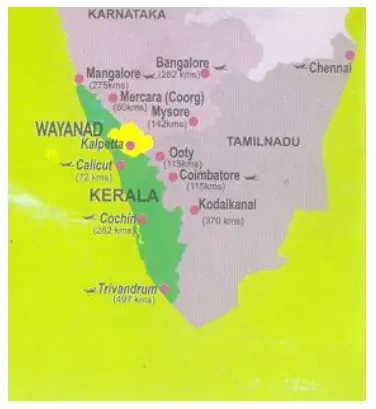
Understanding Sungrazing Comets
- Sungrazing comets represent a distinct category of comets that approach the sun closely at their nearest point, known as perihelion.
- To qualify as a sungrazer, a comet must come within about 850,000 miles of the sun at perihelion, with some even venturing within a few thousand miles.
- The extreme proximity to the sun presents significant challenges for these comets, including exposure to intense solar radiation, leading to the evaporation of their water and other volatile substances.
- Moreover, the physical pressure exerted by solar radiation and the solar wind contributes to the formation of their characteristic tails.
- As sungrazing comets draw closer to the sun, they experience exceptionally strong tidal forces and gravitational stress, further complicating their journey.
- Regrettably, many sungrazers do not survive their passage around the sun due to the harsh conditions they encounter. Though they do not directly collide with the solar surface, the sun's conditions often lead to their destruction, with most evaporating in the hot solar atmosphere.
Orbital Characteristics of Sungrazing Comets
- The majority of observed sungrazing comets follow a consistent orbital path known as the Kreutz Path, which takes approximately 800 years to complete.
- These comets collectively belong to a group known as the Kreutz Group, believed to be fragments from a single large comet that fragmented thousands of years ago.
- The far end of the Kreutz path lies 160 times farther from the sun than the orbit of Earth, indicating the vast extent of their orbital journey.
Understanding Comets
- Comets are remnants from the early formation of the solar system, comprised of dust, rock, and ice.
- They traverse highly elliptical orbits around the sun, which can take hundreds of thousands of years to complete.
- While they may vary in size from a few miles to tens of miles wide, as comets approach the sun, they heat up, emitting gases and dust into a luminous head that can exceed the size of a planet.
- The gases and dust ejected from the comet form a distinct tail that stretches millions of miles away from the sun.
- According to NASA, as of January 2023, there are 3,743 known comets, with many more believed to exist beyond Neptune in the Kuiper Belt and the distant Oort cloud, located far beyond Pluto.
Source: LS
Mange Disease
In News: The forest department is currently overseeing the spread of mange within a pack of Asiatic wild dogs in the Mudumalai Tiger Reserve (MTR) located in the Nilgiris.

Overview of Mange Disease and Key Facts About Asiatic Wild Dogs
Mange Disease
- Mange disease is a skin ailment affecting animals, caused by mite infestations, leading to inflammation, itching, thickened skin, and hair loss.
- The most severe form of mange is caused by the mite species Sarcoptes scabiei, which is also responsible for human scabies.
- Various types of mange affect different domestic animals, with some mite species infesting only specific animal species.
- Transmission occurs through direct contact between animals or through contact with objects that have been in contact with infected animals.
- Most forms of mange are treatable with appropriate veterinary care.
Key Facts About Asiatic Wild Dogs
- Asiatic wild dogs, also known as Indian wild dogs, whistling dogs, red wolves, red dogs, and mountain wolves, are wild canids found in the forests of central, south, and southeast Asia.
- They are distributed throughout Eastern and Southeastern Asia, ranging from Siberia in the north to some Malaysian islands in the south and the Indian peninsula in the west.
- In India, they are found in three main clusters: the Western and Eastern Ghats, the central Indian landscape, and North East India, with the Western and Eastern Ghats being a stronghold region.
- Their habitat includes dense jungles, steppes, mountains, scrub forests, and pine forests.
- Conservation status: Endangered according to the IUCN Red List, listed under Schedule II of the Wildlife Protection Act 1972, and included in Appendix II of CITES.
Source: TH
Decoding state budgets: Can growth projections keep pace with reality?
In News: A recent article discusses different facets of state budgets and underscores the significant variations between actual grants disbursed by the Centre to states and the estimates provided by the states themselves, particularly concerning Centrally Sponsored Schemes.
Understanding the Fiscal Position of Indian State Governments
Concerns Regarding State Finances
- Reliance on Own Revenues
- About half of the total revenues of states come from their own tax revenues (SOTR), making any deviation from projected growth rates impactful.
- The growth of key components of own taxes, such as sales tax and state GST, has been below expectations, impacting revenue projections.
- Devolution from the Centre
- Transfers from the Centre account for 40-45% of state revenues, with tax devolution projected to increase but showing variability.
- States have seen fluctuations in actual grants received compared to estimates, particularly in Centrally Sponsored Schemes (CSS).
- Debt Issuance
- Actual debt issuance has exceeded projections, possibly due to factors like holding larger cash reserves during the Model Code of Conduct period.
- Gross borrowing is expected to rise significantly, potentially impacting fiscal health.
- Capital Spending
- Capital spending is anticipated to start slowly due to elections and may remain subdued during the monsoon months, leading to back-ended spending.
- Technical Inefficiencies in Tax Collection
- High technical inefficiencies exist in collecting state taxes, affecting revenue generation and leading to tax evasion.
- Lack of Uniformity in Tax Structures
- Lack of uniformity in GST slabs and motor vehicle tax structures across states creates complexity and challenges in revenue collection.
- Vertical Fiscal Imbalance
- Vertical fiscal imbalance exists between the Union and state governments, with states having major expenditure responsibilities but limited tax powers.
- Concerns Regarding Cess and Surcharge
- Revenue collected from cess and surcharge is exclusively at the disposal of the Union government, posing challenges for state finances.
Suggestions for Improving State Finances
- Balance Between Tax and Non-Tax Revenues
- States should aim to increase their own tax and non-tax revenue ratios sustainably while aligning financial resources with state priorities.
- Prioritizing Private Investments in Less Developed States
- Less developed states should receive focused attention to attract private investments and aid their growth potential.
- Implementing Recommendations of Finance Commissions
- States should adopt recommendations from finance commissions for restructuring government finances, taxation reforms, subsidy rationalization, and fiscal transfers.
- Rationalizing Revenue Deficits
- States should avoid borrowing for revenue expenditures and focus on increasing revenue streams to cover essential expenditures.
- Harnessing Royalty Rates on Minerals
- States should advocate for regular revisions of royalty rates on minerals to maximize revenue from this source.
Conclusion
Improving state finances requires comprehensive strategies including enhanced revenue mobilization, prudent fiscal management, and efficient resource utilization. By prioritizing economic growth, reducing unnecessary expenditures, and implementing recommended reforms, states can strengthen their financial positions and better serve their citizens.
|
UPSC Previous Year Questions Prelims (2018) Q. Consider the following statements:
Which of the statements given above is/are correct? (a) 1 only Ans: C Mains (2019) Q.1 Public expenditure management is a challenge to the Government of India in the context of budget-making during the post-liberalization period. Clarify it. Mains (2014) Q.2 Normally countries shift from agriculture to industry and then later to services, but India shifted directly from agriculture to services. What are the reasons for the huge growth of services vis-a-vis the industry in the country? Can India become a developed country without a strong industrial base? |
Source: IE
Share the article
Get Latest Updates on Offers, Event dates, and free Mentorship sessions.

Get in touch with our Expert Academic Counsellors 👋
FAQs
UPSC Daily Current Affairs focuses on learning current events on a daily basis. An aspirant needs to study regular and updated information about current events, news, and relevant topics that are important for UPSC aspirants. It covers national and international affairs, government policies, socio-economic issues, science and technology advancements, and more.
UPSC Daily Current Affairs provides aspirants with a concise and comprehensive overview of the latest happenings and developments across various fields. It helps aspirants stay updated with current affairs and provides them with valuable insights and analysis, which are essential for answering questions in the UPSC examinations. It enhances their knowledge, analytical skills, and ability to connect current affairs with the UPSC syllabus.
UPSC Daily Current Affairs covers a wide range of topics, including politics, economics, science and technology, environment, social issues, governance, international relations, and more. It offers news summaries, in-depth analyses, editorials, opinion pieces, and relevant study materials. It also provides practice questions and quizzes to help aspirants test their understanding of current affairs.
Edukemy's UPSC Daily Current Affairs can be accessed through:
- UPSC Daily Current Affairs can be accessed through Current Affairs tab at the top of the Main Page of Edukemy.
- Edukemy Mobile app: The Daily Current Affairs can also be access through Edukemy Mobile App.
- Social media: Follow Edukemy’s official social media accounts or pages that provide UPSC Daily Current Affairs updates, including Facebook, Twitter, or Telegram channels.


